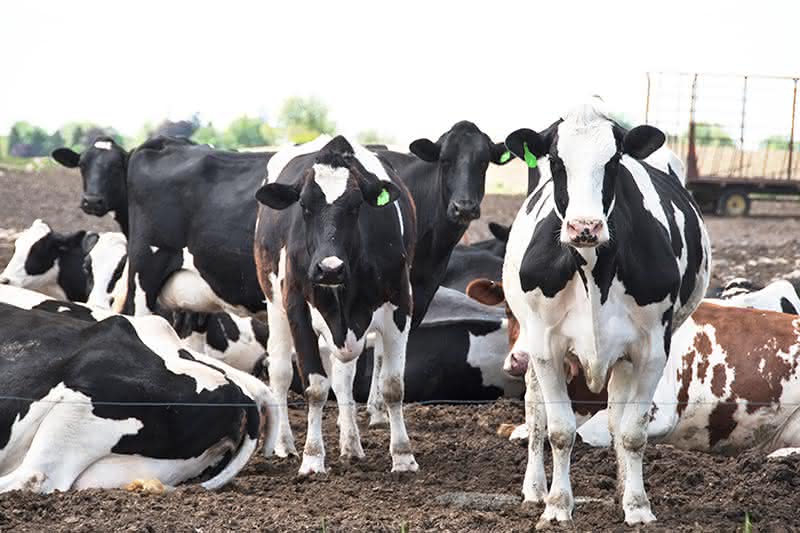What is Cattle Heat Stress?
Cattle Heat Stress Costs Producers Money
Heat and humidity are tough on cattle. Rising temperatures and humidity result in increasing body temperatures, with very negative consequences. Even cattle living in fairly moderate climates may experience periods of heat stress. Heat stress causes a wide range of behavioral and medical issues in cattle – all of which cost the dairy or beef producer money.
-
Cattle lose their appetite when their body temperature exceeds critical thresholds, causing reduced dry matter intake, milk yield, growth and weight gain and resulting in the loss of feed rations to spoilage. Loss of appetite
Loss of appetite -
Heat stress impacts fertility and reproductive efficiency, causing losses in cow calf and dairy operations. Reduced fertililty
Reduced fertililty -
Medical problems can quickly arise in heat stress situations, including lameness from disruption of the digestive process, impaired immunity, and in the worst cases, rapid death. Prone to health issues
Prone to health issues -
The transportation of heat stressed cattle may have a negative effective on carcass quality. Reduced carcass quality
Reduced carcass quality
Heat Stress Management
Reducing cattle heat stress, and the associated losses in productivity and performance, is worth every cattle manager’s attention. Effective heat stress management requires an understanding of all factors contributing to a cow’s heat energy balance.
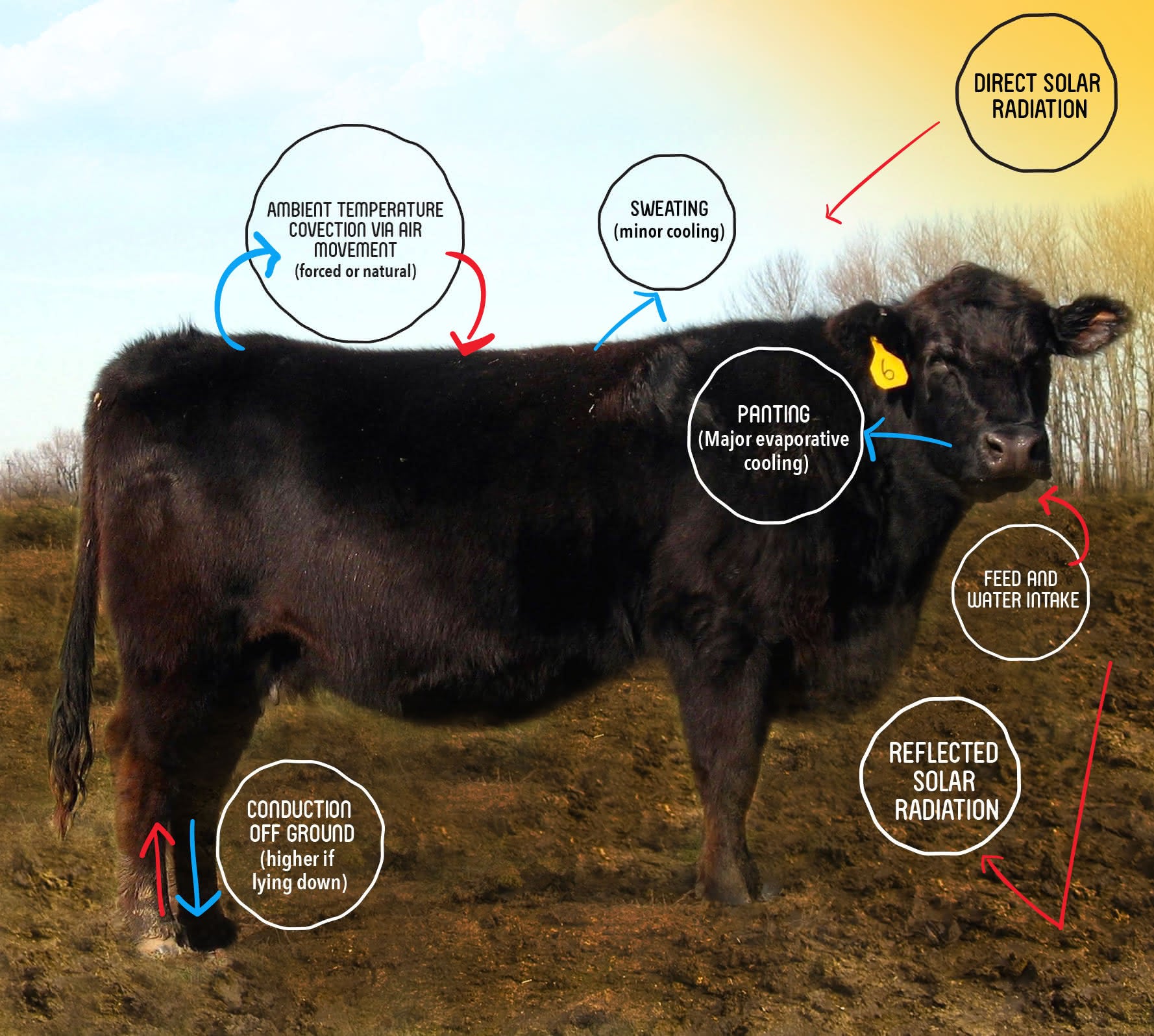
Cattle generate heat metabolically through digestion and activity and also accumulate heat from their environment – ambient temperature, solar radiation and radiant heat from the ground (reflected solar radiation as well as heat generated by decomposing manure). They dissipate heat through non-evaporative cooling – radiation, conduction and convection back into their environment – as well as through evaporative cooling – sweating and panting. They can also reduce heat load through taking in cool water. In persistent hot, sunny, humid conditions, the cooling mechanisms are insufficient to dissipate all accumulated heat, and the cow’s body temperature begins to rise, triggering the cascade of negative heat stress impacts.
Heat stress management practices include providing shade, enhancing ventilation by adding fans or passive ventilation, enhancing evaporative cooling with sprinklers, providing cooled water, and modifying feed to increase dry matter intake and reduce waste. Each of these practices ALSO cost money, so the smart producer’s goal is to implement management practices every time they are needed, but ONLY when they are needed.
Fortunately, extensive academic and industry research into livestock heat stress management has generated excellent heat stress reduction guidance that is based on proven cattle-specific environmental measurements and models. Implementing a measurement-based heat stress management plan is the most effective way to minimize heat stress losses without wasting money.
"Just consider a 300-cow-calf operation with spring calves that traditionally gain 2.0 lbs. per day, only to stall out during a 21-day heat-stress period in August. When these calves are sold in the fall (assumed at the same time of the year); my calculation for their failure to gain weight/subsequent decreased income is as follows: 300 spring calves x 2 lb./head/ x 21 days x $2.25 (demonstration autumn price — weaned 600-lb. steers) = $28,350. That's nearly a loss of $30,000 revenue directly due to heat stress."
Objective and accurate measurements at pen level are critical to planning your heat management strategy.

Measure
By the time signs and symptoms of heat stress such as panting and drooling are visible in your cattle, production losses have already begun. Cattle suffer heat stress before people do, so simply waiting until you feel the heat intensify will also not ensure heat losses are prevented. Because cattle accumulate heat, if they do not have an opportunity to dissipate heat through overnight temperature cooling or environmental modifications, your herd's heat problems are increasing invisibly.
The first step in any cost-effective heat management plan is to accurately measure conditions wherever cattle are contained, at the pen level, and then determine your cattles’ risk of heat stress injury. To provide more accurate management guidance, researchers and government agencies have developed a variety of cattle-specific measurements and management models:
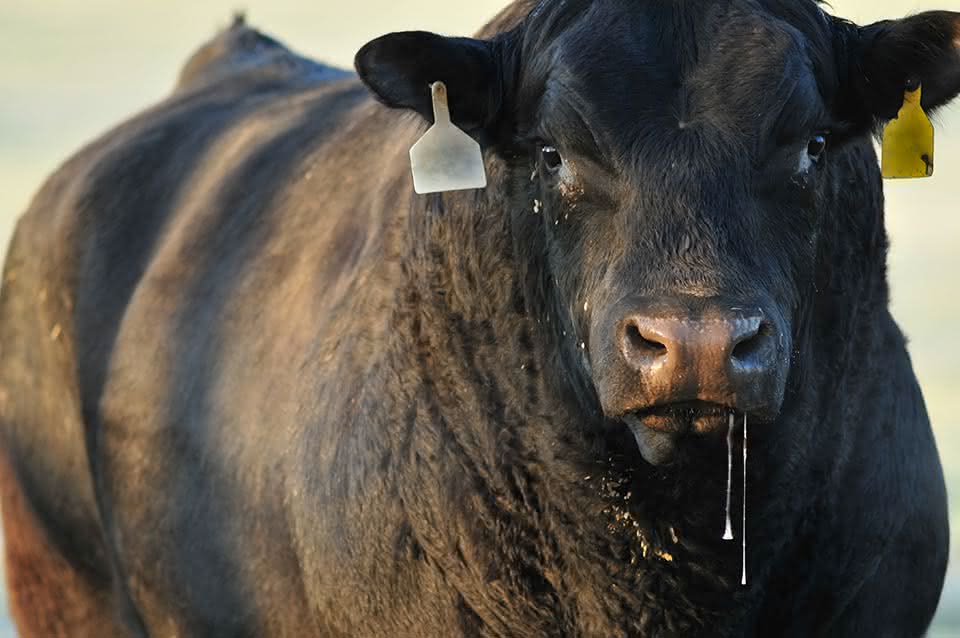
"Panting, increased water consumption (presence at the waterer), lethargy or combative behavior, drooping heads, etc. are good signs but often come without sufficient reaction time."
Cattle Specific Heat Stress Measurements and Models

THI - Temperature-Humidity Index
THI is calculated based on ambient temperature and relative humidity and has been extensively applied in research and management to represent the overall impact of moderate to hot conditions on cattle, especially those who are housed. Although THI is similar to the Heat Index typically reported in the local weather report, it is calculated differently. Accordingly, to obtain THI without a dedicated instrument, it is necessary to take a local temperature and humidity reading and refer to a reference table or perform calculations.
HLI – Heat Load Index
The limitation of THI is that is does not take into account sun, air flow, or accumulation effects. HLI is a more complete environmental index which includes temperature, relative humidity, and the additional parameters of solar radiation and wind speed. These added parameters are most important for assessing heat stress risk in exposed, unshaded cattle. These parameters are derived from the Globe Temperature – an advanced meteorological measurement which uses a heat-absorbing metal globe. Because Globe Temperature is not available on traditional weather stations, it has previously been difficult to implement management practices based on HLI.
AHLU – Accumulated Heat Load Units
AHLU is the most complete cattle heat stress model – addressing the fact that cattle accumulate heat load during prolonged heat events where they have insufficient environmental night cooling. THI and HLI alone may not predict the level of cattle heat stress because they do not address this accumulation impact.
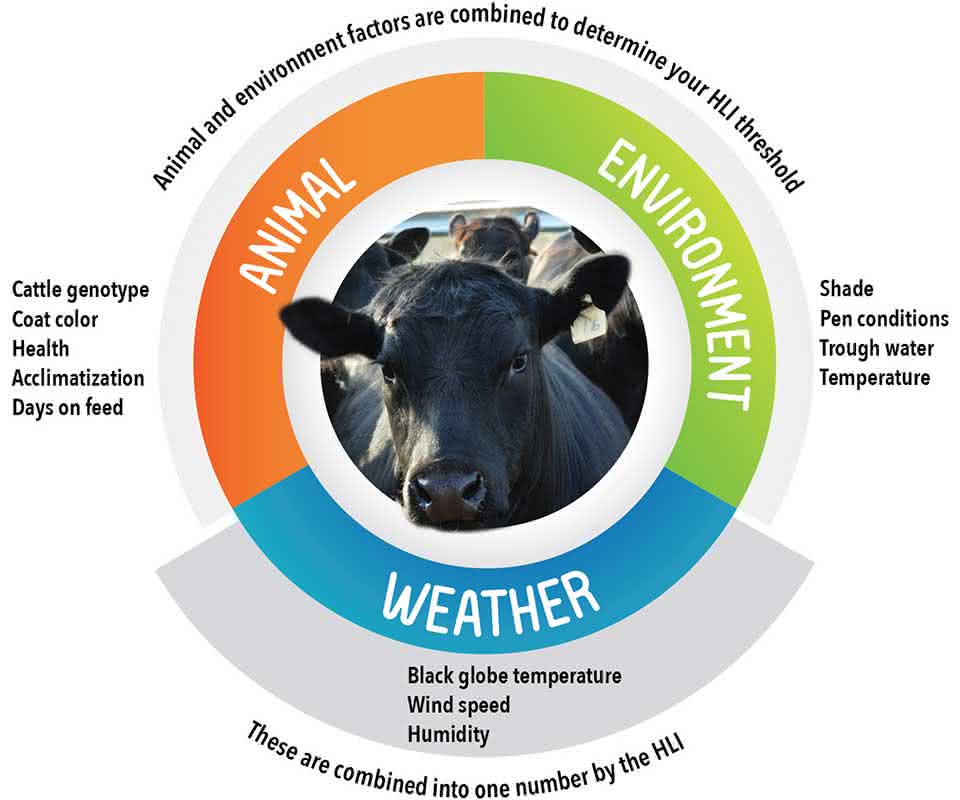
Calculating AHLU
In order to calculate AHLU, an HLI Threshold is determined for each group of cattle. This is the HLI value above which those cows will start to accumulate heat. The HLI Threshold will vary depending on many factors, including the breed, color, feed state, acclimatization and general health of that group of animals, as well as the environmental conditions of their housing:
(The Bos Taurus breeds prevalent in Western beef and dairy operations are particularly subject to ill effects from heat as they are less efficient at cooling themselves than Bos Indicus breeds.)
Because AHLU is an accumulation measure, it must be measured at the animals' location over an entire heat event to provide accurate management guidance. Previous methods of measuring and calculating AHLU were extremely time-consuming and complex, requiring the use of very expensive equipment to obtain the base measurements, referencing complex tables to obtain the correct HLI Threshold, then entry of hourly measurements into spread sheets to calculate the accumulated heat load units. All in all, a practice that is not likely to be adopted by most cattle or dairy operations, no matter how effective.
"Death losses indicated that the local conditions were more severe at the affected feedlots than at two nearby (35 km) weather stations that also had feedlots in the immediate area without cattle deaths, stressing the value of an on-site weather station."
The Kestrel Solution
Kestrel has been building weather and environmental meters for over two decades. For many farmers, a pocket Kestrel meter has been their standby tool for monitoring conditions for spraying, irrigation, harvesting and processing. Kestrel also has developed some of the most advanced meters on the market for monitoring human heat stress in athletics and demanding work scenarios. Kestrel has brought its farming experience and technical and physiological expertise to bear to develop affordable, easy-to-use solutions to allow cattlemen and dairy operators to accurately measure and monitor cattle heat stress conditions without reference to complex tables and spreadsheets.
Kestrel’s line of Agriculture Meters includes handheld and portable solutions for heat stress measurement specific to dairy and beef cattle. The Kestrel 5400AG Cattle Heat Stress Tracker can be easily set up for a particular group of cattle with simple menu picks for animal and environment variables. It can then be mounted at the pen where it will automatically track day and night conditions and calculate the current AHLU. You can even receive alerts on your mobile phone signaling the right time to implement heat stress management plans for maximum effect with minimum cost. The Kestrel 5000AG Livestock Environmental Meter captures and logs vital information on micro-climate conditions allowing you to make informed, data-backed decisions to better manage the overall health and productivity of site operations. This unit provides critical measurements and calculations needed for herd health, ventilation assessments, grain storage management, nutrition strategy development, livestock protection, and more. Easily upload and analyze weather information with an optional wireless data transfer feature or connect to a laptop using a Dongle accessory. The Kestrel 5500AG Agriculture Weather Meter is a complete tool designed to meet the needs of agriculture production, both livestock and crop. This lightweight, handheld, multi-function meter can be used inside and out for barn/facility environmental assessments, commodity storage, and field and spraying monitoring. With optional wireless data transfer, current and logged data can be easily sent to your mobile device or laptop. The Kestrel DROP D2AG Livestock Heat Stress Monitor is a small data logger that tracks temperature, humidity and THI in any indoor or outdoor location. Extremely low cost and easily read on your mobile phone from up to 100’ away, you can afford to place many Kestrel DROPs around your facility.
Each of these products were engineered with input from cattle heat stress experts for maximum utility and ease of use: Dr. Daniel Thomson, Kansas State University; Dr. Tom Noffsinger, Production Animal Consultation; Dr. Kev Sullivan, Bell Veterinary Services; Dr. Donald Spiers, University of Missouri.
The Kestrel Cattle Heat Stress trackers were developed for producers to improve summer heat stress management and maintain herd performance, minimize production losses, protect cattle and increase their bottom line.
"In the last ten years there have been several heat events in the Midwest; direct and indirect financial losses for these events are estimated at over $75 million for the cattle industry alone. These weather events are unavoidable but management strategies can reduce the impact of heat waves."
Actions to Minimize Heat Stress USDA

Manage
Managing heat events and implementing the proper management plans can mean the difference between life and death of your cattle and send savings straight to your bottom line. With accurate microclimate environmental data and cattle-specific heat stress measurements from your Kestrel Cattle Heat Stress Tracker, you will know when and where it is necessary to implement your plan.
There are a variety of management options available depending on the site characteristics and options available to your location. These can include:
- Providing temporary or permanent shade structures, particularly over vulnerable animals
- Adding fans
- Improving air flow by removing obstructions
- Wetting the animals or the ground with sprinklers (effective in low humidity and wind – may be counter-productive in high humidity)
- Changing the nutrition mix to a low heat increment diet
- Changing feeding schedule
- Increasing availability of water to ensure all animals have ready access
- Removing manure buildup, which creates additional heat
- Avoiding moving the animals
Below is a sampling of links from widely respected organizations with recommendations as to how to manage cattle during an extreme heat event:
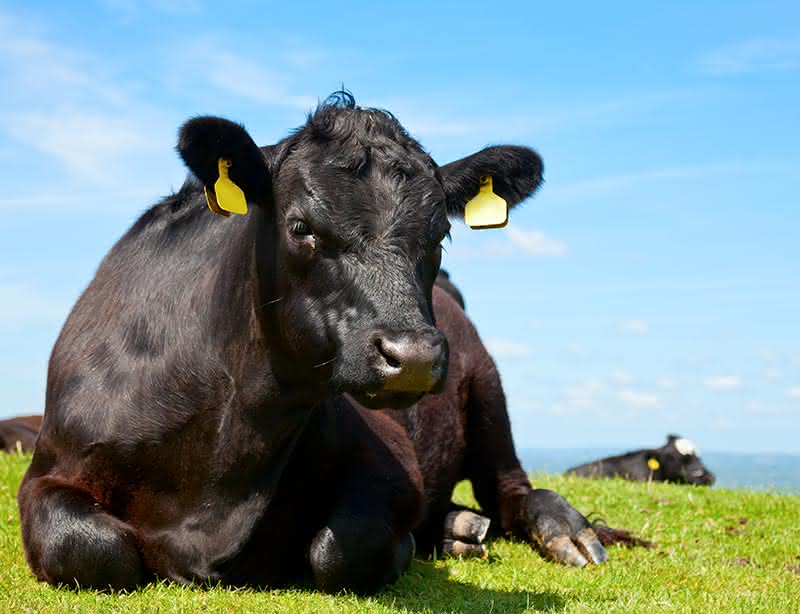
"Infrastructure upgrades such as shade structures, sprinklers and enhanced watering points together with pad and animal management strategies and dietary adjustments can help stock cope with hot conditions and limit production and cattle losses due to EHL. A proactive approach to the management of EHL is more effective than a reactive response once an EHL event has occurred."
- Heat load in feedlot cattle, Meat & Livestock Australia
"If following [Best Management Practices] could result in a 1 percent reduction in shrink, among the more than 28 million feeder cattle shipped at least once in the U.S., there would be a result in a savings of more than $325 million in value at the feeder calf level. While hypothetical, this example demonstrates potential economic benefits to the cattle industry from using BMPs for transporting cattle."
- Beef Issues Quarterly, September 2015 (BMP’s include not transporting stressed cattle, and monitoring conditions during transport to ensure heat loading thresholds are not exceeded.)

Maximize
Implementing a measurement-based heat stress management plan helps you maximize herd PERFORMANCE and profits!
-
 Improve Weight Gain
Improve Weight Gain -
 Reduce Feed Loss
Reduce Feed Loss -
 Reduce Healthcare Costs
Reduce Healthcare Costs -
 Avoid Livestock Loss
Avoid Livestock Loss








